Table of Contents
How important is magnesium for athletes? New research suggests that even minor deficiencies in magnesium intake can slow sports performance. Keep reading and you will learn much more about this mineral.
Ask any athlete to name the key minerals to boost performance, and they will most likely mention calcium, iron, zinc and perhaps even chromium. But it is unlikely to mention magnesium. Despite the important role of magnesium in energy production, many coaches and athletes have no idea of its vital importance for maintaining health and performance.

It is a fact that magnesium intake has fallen by less than half compared to recorded income 100 years ago, and continues to decline. Nevertheless, many scientists say that the amount of magnesium needed for optimal health has been underestimated in the past, and new research suggests that even small deficiencies in magnesium intake can seriously harm sports performance. Obviously, no serious athlete can overlook magnesium intake!
BASIC INFORMATION ABOUT MAGNESIUM
Pure magnesium is a silvery white metal that burns with a brilliant luster – something you’ve probably seen in chemistry lessons. It is the second most abundant mineral in cells, immediately after potassium, but approximately 57 grams found in the human body are present not as metal but as magnesium ions (positively charged magnesium atoms situated either in solution or complexed with other tissues, such as bone).
About a quarter of this magnesium is found in muscle tissue and three fifths in the bones; but less than 1% of it is found in blood serum, which is used as the most common indicator of the state of magnesium.

Magnesium is the eighth most abundant element in the Earth’s crust, although its elemental form has not yet been found. Magnesium blood serum can be further subdivided into free ions, complex and protein-bound portions, but it is the ionic portion that is considered to be most important in the measurement of magnesium levels because it is physiologically active.
Magnesium is also found in unrefined whole grain cereals, as whole grain bread, and also in green leafy vegetables, nuts and seeds, peas, beans and lentils (see table below). Fruits, meat and fish are supplied with low levels as well as refined foods.
The general idea that milk and dairy products are a rich source of magnesium is a mistake. The magnesium content of plant foods tends to only reflect the concentration of this mineral in the soil and the growth conditions of the soil in general, since especially magnesium is not routinely used by farmers during intensive fertilization. (1)
|
TABLE: Magnesium content in common foods |
|
|
Pumpkin seeds (baked) |
532 |
|
Source; USDA Nutrient Database |
|
Magnesium is a well soluble mineral, which is why cooking vegetables can result in significant losses; for cereals and grains, it tends to be concentrated in germ and bran, explaining why white refined grains contain relatively little magnesium compared to unrefined.

THE ROLE OF MAGNESIUM IN THE BODY
Magnesium plays a number of roles in the body, it is needed in more than 325 enzymatic reactions, including those involved in the synthesis of fats, proteins and nucleic acids, neurological activities, muscle contractions and relaxation, heart activity and bone metabolism.
ATP METABOLISM
Even more important is the key role of magnesium in both anaerobic and aerobic energy production, especially in the metabolism of adenosine triphosphate (ATP), the “energy currency” of the body. If someone was interested in how we were able to summon energy to perform many activities under different conditions, the answer is largely ATP. Without ATP, the body would simply not function.
ATP synthesis requires magnesium-dependent enzymes called “ATPases”. These enzymes must work very hard: the average person can store no more than about 85g of ATP, but during strenuous exercise, the rate of ATP turnover is phenomenal, as 15 kg of ATP per hour is broken up and reformed (from adenosine diphosphate and phosphate)!
LACK OF MAGNESIUM
In normal adults, magnesium deficiency leads to altered cardiovascular function, including electrocardiographic abnormalities (2,3), carbohydrate metabolism disorders, insulin resistance and decreased insulin secretion (2,4) and high blood pressure (5).
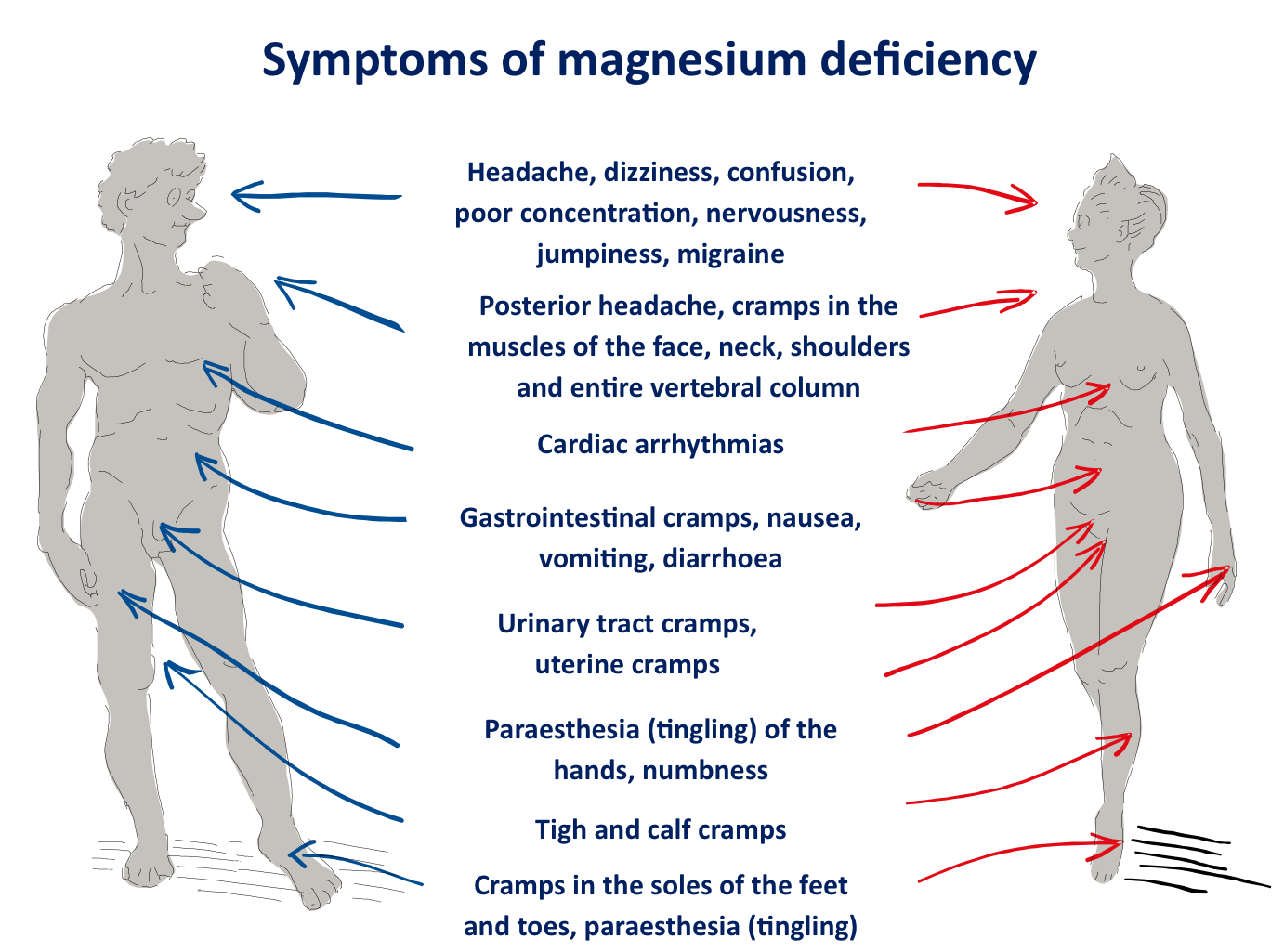
Diseases associated with magnesium imbalance and deficiency include coronary heart diseases, nerve-muscle diseases, kidney disease, asthma (6), migraine, premenstrual syndrome, pre-eclampsia and eclampsia (both causing potentially serious pregnancy complications), climacteric complaints bones(3) and even obesity.
The United Kingdom recommends that magnesium intake (a daily amount considered sufficient to prevent a deficiency in 97.5% of the UK population) should be set at 300mg for men and 270 milligrams for women (7). The US has recently revised its numbers up and now recommends intake of 400mg per day for men aged 19-30 and 420 mg for people over 30 years of age. The numbers for women over 30 are 300 and 310 milligrams per day (8). However, some researchers believe they should be set even higher, 450-500mg / day (9).
MANY PEOPLE HAVE A LACK OF MAGNESIUM
Magnesium dietary intake has been decreasing over the last 100 years from about 500 mg / day to 175-225mg / day (10), and recent research has indicated that the average magnesia intake in women is very low at 228 milligrams per day (11). However, since this figure is derived from the one-day nutrition for recovery, actual magnesium intake may be overestimated (12).

Meanwhile, the Food Standards Agency in the UK estimates that the average daily intake of magnesium for both men and women is only 227 milligrams – just two-thirds of the recommended daily dose (RDA).
The above data shows that many people do not achieve optimal magnesium intake, as confirmed in a number of studies. For example, American scientists have found that more than 60% of adults did not accomplish the previous (below) RDA for magnesium (13).
LACK OF MAGNESIUM IN ATHLETES
Even athletes who could be expected to be more careful about their diet are not immune to the lack of magnesium. For example, a 1986-87 study found that gymnasts, footballers and basketball players consumed only about 70% RDA (14), while female runners were even worse, with a recorded income of about 59% RDA (15).
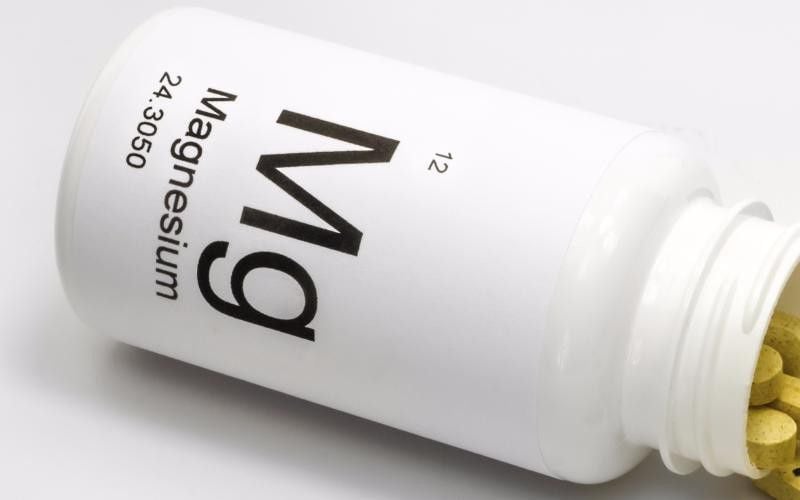
Given the important role of magnesium in energy production, it became clear that:
• Can this too frequent suboptimal magnesium intake affect sports performance?
• Could extra magnesium intake – above RDA level – increase performance?
While there is much evidence that oral magnesium therapy improves cardiac function and exercise tolerance in patients with ischemic heart disease (16, 17),until recently there has been little evidence of the effects of suboptimal magnesium uptake in healthy adults.
3-MONTH MAGNESIUM STUDY
In a very strictly controlled three-month study conducted last year, the effects of magnesium depletion during sports performance were observed in 10 women – the results were fascinating (18).
In the first month, women were given a diet with an insufficient amount of magnesium (112 milligrams per day), supplemented with 200mg of magnesium per day so that the total magnesium content by RDA was 310 milligrams per day. In the second month, the supplement was withdrawn to maintain a magnesium-deficient diet, but in the third month the magnesium level was restored.
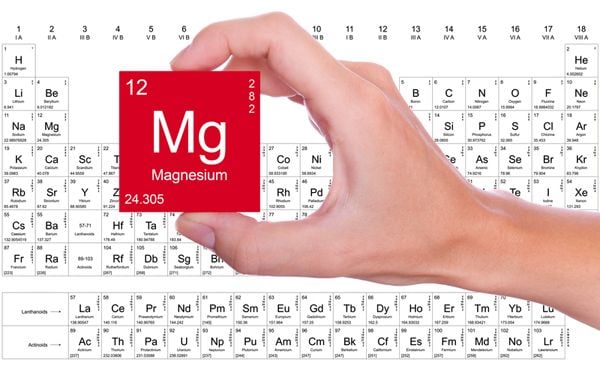
At the end of each month, women were asked to increase their cycle until they reached 80% of their maximum heart rate when a large number of measurements were taken including blood tests, ECG and respiratory gas analyzes.
The researchers found that for the load, oxygen consumption, total and cumulative use of pure oxygen, and heart rate increased significantly during the period of magnesia limitation. In simple terms, lack of magnesium reduces metabolic efficiency, increases oxygen consumption and the heart rate required to exercise – exactly what athletes don’t want!
CONCLUSION
Scientists conclude: This study provides the first evidence that the lack of magnesium consumed by physically active people worsens exercise functions. The mechanism behind this effect is unclear, but it seems that the lack of magnesium may cause disconnection of the respiratory chain, thus increasing the amount of oxygen required to maintain ATP production.
There is also evidence that the lack of magnesium increases energy consumption, oxygen consumption during exercise, reduces the efficiency of muscle relaxation, which accounts for an important fraction of the energy needed in sports such as cycling (19).

FURTHER STUDIES
One study of male athletes who took 390mg of magnesium for 25 days resulted in an increase in oxygen intake and performance in load training (20). The second study with magnesium supplementation led to a reduction in pulse, ventilation, oxygen uptake and carbon dioxide formation (21). The third study of physically active students who received 8mg of magnesium per kilogram of weight showed a significantly higher performance in addition to reducing oxygen consumption during submaximal training (22). However, other studies that looked at physically active people with normal magnesium concentrations did not show any functional or performance improvements connected with the supplementation (23,24).
There is evidence that extra magnesium can improve performance if magnesium intake falls below optimal levels. However, in subjects who have consumed magnesium at the optimum or increased rate, there is hardly any evidence that the magnesium provides extra benefits.
It is therefore very important for athletes to keep the magnesium levels at the optimum level. But what are the ways to determine the magnitude of magnesium in the body? Muscle magnesium obtained from biopsy is the most accurate form of measurement. But it is time consuming, invasive and can cause discomfort. Values of magnesium can also be obtained from urine samples, but they are very variable for accurate measurements (6).

MAGNESIUM LEVEL TESTING
Total blood magnesium (TMg) values are the most widely used test, but its disadvantage is that it also includes complex and protein bound magnesium, which is only the ionic portion and is physiologically active. This test also fails to recognize the magnesium that is produced in the body by exercise.
The current introduction of ion-selective electrode technology allows scientists to measure ionic magnesium directly and is considered one of the best methods. But even this is not an absolutely accurate measurement since the magnesium values in the body are unstable and in the morning the values were higher than in the evening.
WHAT ARE ION SELECTIVE ELECTRODES (ISE)?
Ion-selective electrodes are used in various industries to determine the concentration of different ions in aqueous solutions. Some of the main areas where ISE is used are: air pollution monitoring, food processing, paper production and good old explosives.
WHAT IS THE MESSAGE FOR ATHLETES?
First, it is all too easy to get to the lack of magnesium levels, especially if your nutrition is depleted of wholegrain and cereal foods, green leafy vegetables, legumes (peas, beans, lentils), nuts and seeds. And to make matters worse, excessive sugar intake, alcohol consumption, and a nutrition rich in fat, protein, and calcium were all associated with impaired absorption and increased secretion of magnesium.
Although you consume a quality and balanced food, nutrition containing less than 2000kcal per day often struggles to meet the needs of magnesium content.
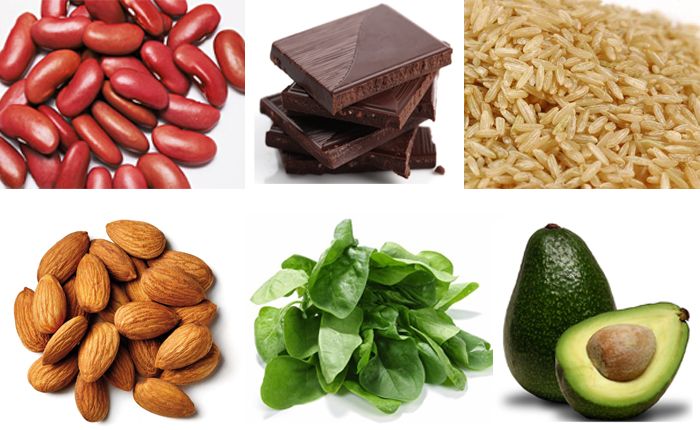
Risk factors and indications of magnesium deficiency
Eating habits associated with low magnesium intake:
• You tend to eat white bread instead of whole grain
• You do not consume enough leafy vegetables
• You do not consume enough nuts, seeds and legumes
• You regularly consume sugar and sweet products
• You regularly drink alcohol
• You follow a diet (low calorie, high protein)
Symptoms of lack of magnesium in the body:
• Muscle cramps or muscle shaking
• Regular or excessive fatigue
• Feeling irritated or lethargy
• Frequent mood swings, including depression
• Premenstrual bloating
• Restless legs during the night
With regard to the potential to greatly deteriorate performance during suboptimal magnesium intake, some athletes should try to increase the proportion of foods rich in magnesium in their nutrition. Even a simple change like eating more whole grain products and increasing the intake of vegetables, nuts and seeds can have a big impact.
Upon receiving magnesium over RDA, power is unlikely to increase, but these supplements are not costly and are non-toxic, so they can be safely used as a fuse. Most forms of supplemental magnesium have a very good tolerance, but supplementing more than 400 milligrams per day is not appropriate.
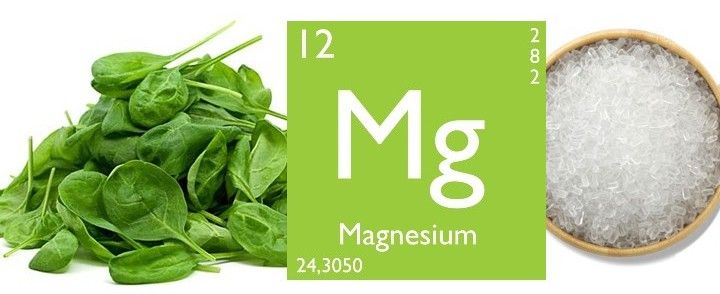
Some forms, such as magnesium oxide, are relatively alkaline and may have an adverse effect in neutralizing gastric acid and disturbing digestion. They should not be taken with food.
Finally, magnesium is best absorbed in small and frequent doses. For example, it is better to take 100 milligrams three times a day than 300 milligrams at a time!
Taken from bodybuilding.com
Sources:
1. National Research Council of Canada: Ottawa, ON: NRCC Publications (1979)
2. Hypertension 21:1024-1029. (1993)
3. Endocrinol Metab Clin N Am 22:377-395 (1993)
4. Diabetologia 33:511-514 (1990)
5. Magnesium and Trace Elements, 10:Measurement 1991-90 (1992)
6. Scandinavian Journal of Clinical and Laboratory Investigation, 55:549-558 (1995)
7. UK Food Standards Agency/COMA
8. US Institute of Medicine and National Academy of Sciences
9. Scandinavian Journal of Clinical and Laboratory Investigation, 56 (Supplement 224): 211-234 (1996)
10. Scandinavian Journal of Clinical and Laboratory Investigation, 54(Supplement 217):5-9 (1994)
11. Clinical Nutrition of the Essential Trace Elements and Minerals:49-67 (2000)
12. J Am Diet Assoc 93:462-464 (1993)
13. Institute of Medicine, Food and Nutrition Board, Washington, DC: National Academy Press, (1997)
14. J Am Diet Assoc;86: 251-3 (1986) and Nutr Res;7:27-34 (1987)
15. Med Sci Sports Exerc; 18(suppl):S55-6 (1986)
16. Am J Cardiol, 91(5): 517-21 (2003)
17. Cardiovasc Drugs Ther, 12 Suppl 2: 153-6 (1999)
18. J Nutr 132:930-935 (2002)
19. J Appl Physiol 65:1500-1505 (1988)
20. Endocrinol Metab Clin N Am 22:377-395 (1993)
21. Magnesium and Physical Activity:227-237 Parthenon Publishing Group London, UK (1995)
22. Med Exerc Nutr Health 4:230-233 (1995)
23. Sports Nutrition: Minerals and Electrolytes:179-187 CRC Press Boca Raton, FL, USA (1995)
24. Int J Sports Nutr 2:154-164 (1992)


Add a comment